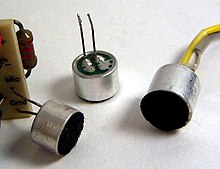Electret microphone
The electret microphone, or more precisely the electret condenser microphone, is a special type of condenser microphone . Thanks to their compact design, low price and good signal quality, electret microphones are manufactured in very large numbers. In modern means of voice communication (telephones, recorders, hi-fi and announcement microphones) they have been replaced by MEMS-based microphones, which are more compact, cheaper and more moisture and temperature stable than electret microphones and usually already have suitable digital interfaces.
history
Electret microphones were first mentioned in the literature in the 1920s. However, the electret materials proposed at the time were not particularly well suited as electrets because of their rapid charge decay, and they could not be produced in the thin layers required for a relatively large microphone capacity. That is why the electret microphones of that time were not granted lasting success. It was only through the invention of the foil electret microphone by Gerhard Sessler and James E. West at Bell Laboratories in 1962 that these difficulties could be overcome. The electret material used was initially PET film and shortly thereafter the thin Teflon film, which is still used almost exclusively today. Such electret microphones have then established themselves commercially.
construction
Electret microphones are condenser microphones with an electret applied during manufacture . Similar to how a permanent magnet carries a frozen magnetic field, an electret carries a frozen electric field. This takes over the bias voltage otherwise necessary for condenser microphones and thus allows easier operation. Due to the high impedance, however, an impedance converter is also necessary here directly on the microphone capsule; the necessary transistor is often already on the microphone capsule.
There are three types of electret microphones:
- Diaphragm Type: The diaphragm itself is the electret.
- Front electret: The electret is applied to the membrane.
- Back electret: The electret is applied to the fixed metal plate.
The electret has a frozen charge Q , which induces a voltage depending on the capacity of the capsule. The direct voltage component of this voltage drains over time via parasitic resistances, so that no voltage is applied to the capsule without the effect of sound. The following relationships result in AC voltages at the capsule when the sound is exposed to the action of the membrane due to the deflection of the membrane and changes in the distance d ( Δd ):
Since the electret does not require a capacitor membrane bias voltage, a voltage of 1.5 V or more is sufficient for simple applications to supply the impedance converter alone. This impedance converter with a very high-resistance input is integrated into the microphone capsule. It is almost always implemented with a field effect transistor (FET), which requires a supply current of less than 1 mA. The operating voltage for this built-in amplifier is provided either internally by a battery or externally by means of a tone lead or phantom power.
A distinction is made between two-pole and three-pole capsules. Three-pole capsules are preferably operated in a drain circuit , while two-pole capsules can only be operated in a source circuit (see picture). With two-pole capsules, the operating voltage does not need to be supplied separately via a separate line or plug contact. While the three-pole variant ensures a low distortion factor , the two-pole variant offers the option of being connected to the sound card of a PC via a two-pole 3.5 mm jack plug . This is why this variant is found as the standard for sound cards.
In recent years, more and more electret measurement microphones have been used. These have complex preamplifiers with up to 120 V operating voltage in order to be able to deliver up to 100 V p-p (peak-peak) high output amplitudes. For example, B. a typical 1/2-inch microphone with a transmission factor (sensitivity) of 50 mV / Pa at 120 dB 1 V, at 140 dB 10 V rms value ; that is 28.2 V p-p .
disadvantage
Electret microphones have the following disadvantages:
- lower sensitivity than classic condenser microphones
- higher series dispersion of the sensitivity due to fluctuations in the thickness and polarization of the electret
- Loss of sensitivity due to aging and loss of charge
- Loss of sensitivity due to high temperatures, total failure in cars in summer at normal temperatures
- mechanical aging of the diaphragm in the diaphragm type
Indirect disadvantages:
- low level stability due to mostly low supply voltage of the impedance converter
- amplified if this is operated in source connection (additional voltage amplification, lack of negative feedback)
literature
- Thomas Görne: Microphones in theory and practice. 8th edition. Elektor-Verlag, Aachen 2007, ISBN 978-3-89576-189-8 .
- Helmuth Wilhelms, Dieter Blank, Hans Mohn: Electrical specialist 3 Telecommunications. 1st edition. BG Teubner Verlag, Stuttgart 1982, ISBN 3-519-06807-9 .





